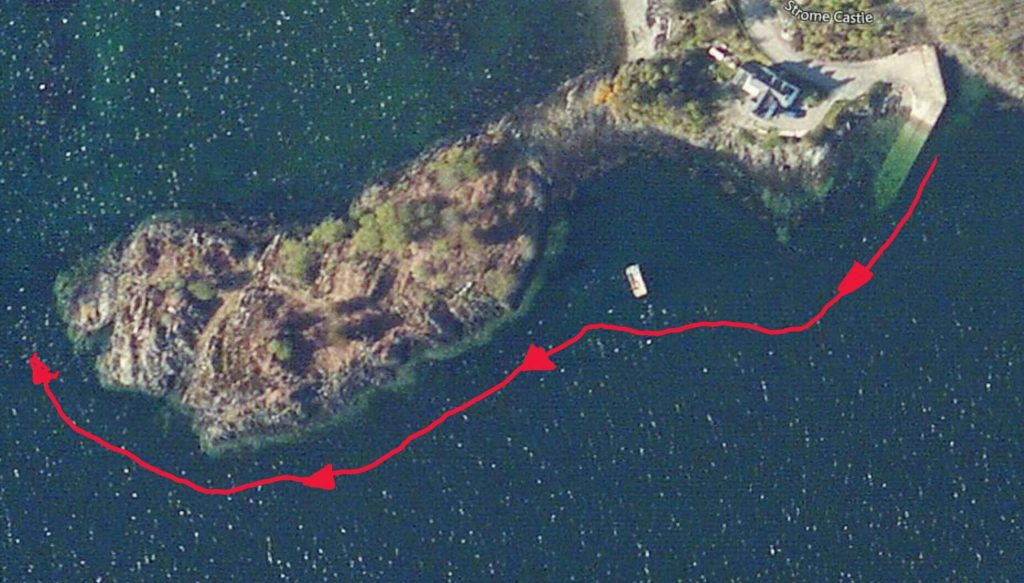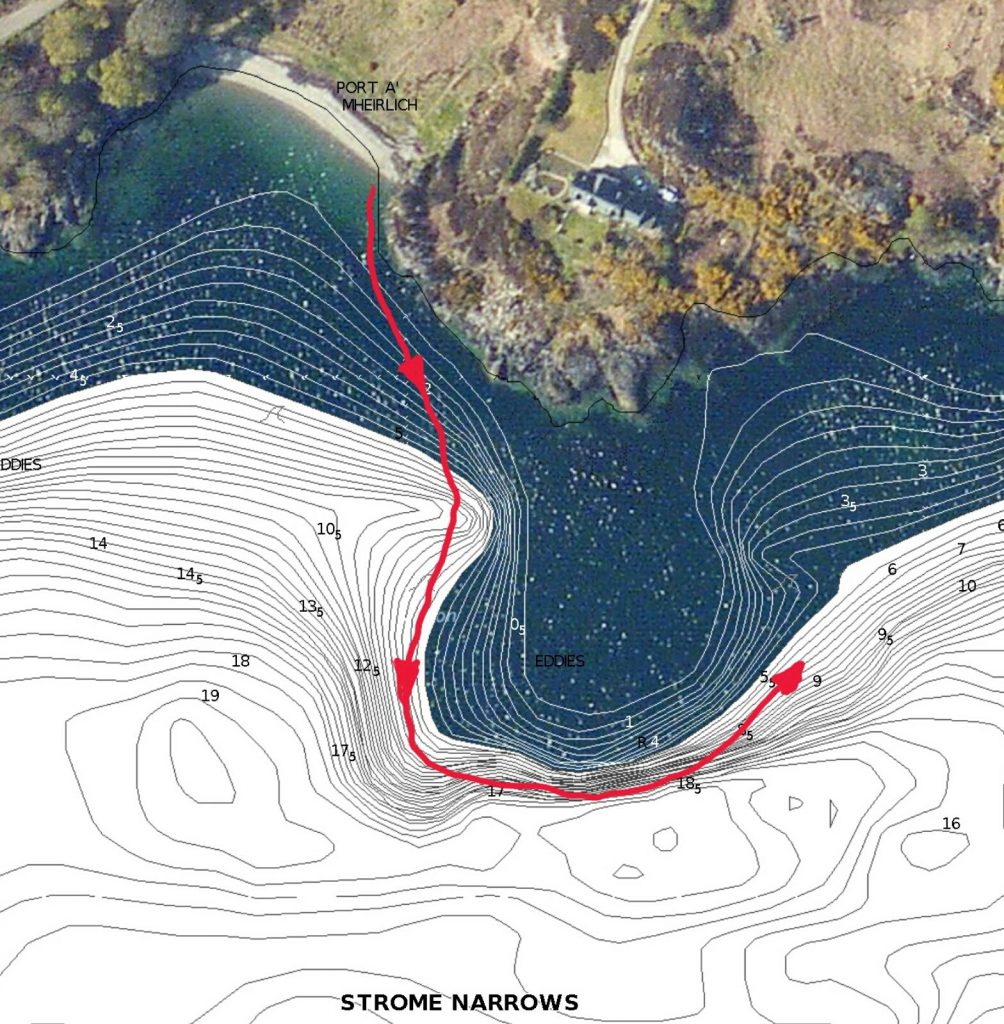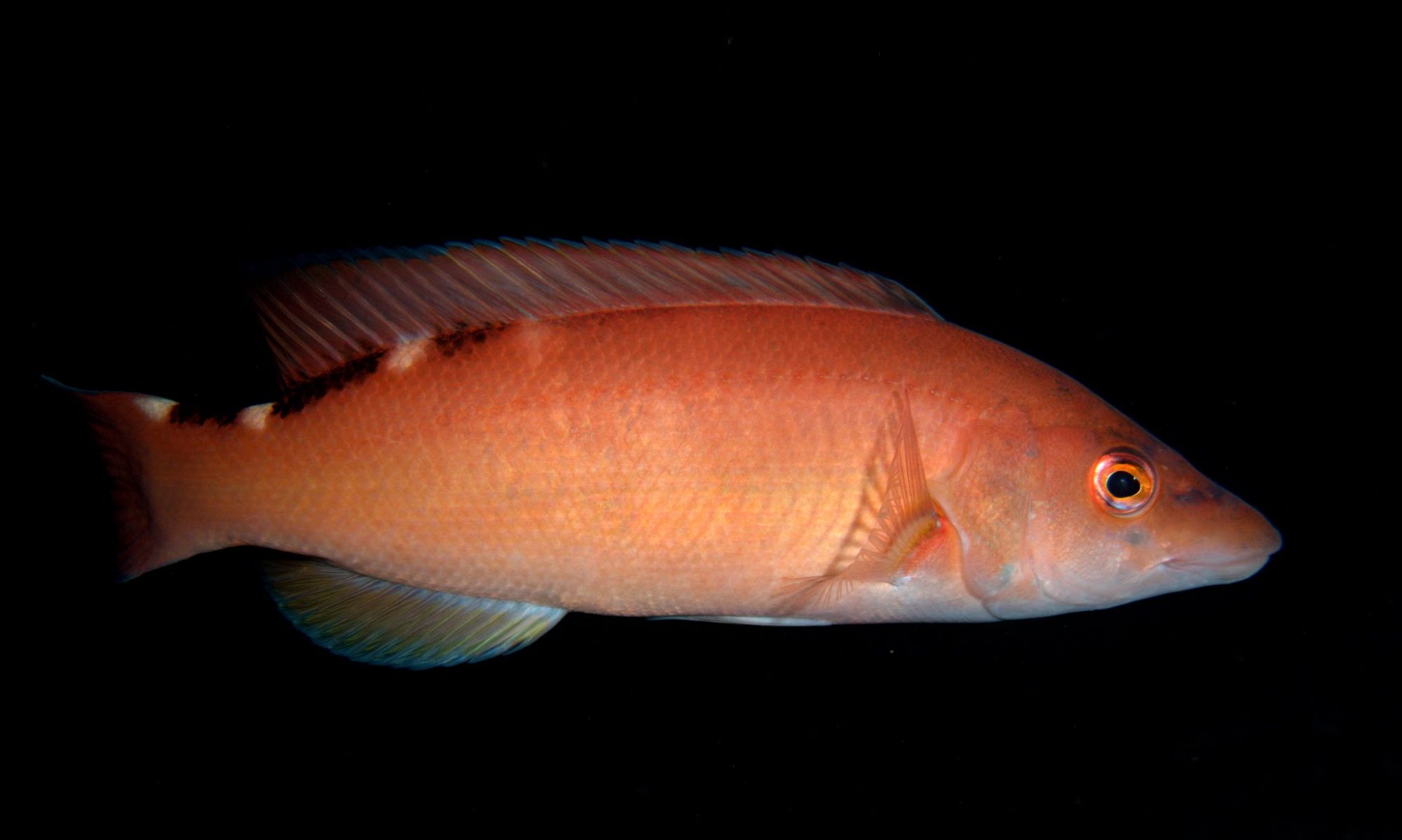The Strome Narrows
When I sit down to look at options for diving (or ‘ploptions’ as I like to call them), the first thing I always look at is a calendar of Spring and Neap tides. I’m a lazy diver and whilst I’m prepared to put a bit of effort into getting to a shore dive site, I don’t like too much exertion while I’m under the water. I’ve done a few head-burster dives in my time and my enjoyment of the dive starts to wane severely if I’m having to fin so hard it feels like my heart might explode and flood my drysuit. Carrying a camera setup that acts a bit like a sail doesn’t exactly help the situation either.
Some of my favourite Scottish dive sites are at the most tidal locations. A month where the Neap tides (when the tidal range is smallest) coincide with the weekends, has me checking out tide times to see which of them is most diveable. If I’m really lucky, there will occasionally be three ‘neapy weekends’ in one month. March 2019 is one such month and I’m excited to be visiting three of my absolute favourite diving locations, starting with the Strome Narrows. Check out the video below for an aerial view of the Strome Narrows taken on a stunning January day a couple of years ago: –
The Strome Narrows are located at the eastern end of Loch Carron. The loch is more than 100 metres deep and around a mile wide in places. At the narrows it shallows to less than 20m and is around a quarter of a mile wide. This accelerates the water through the channel on the incoming and outgoing tides, in places creating eddies where the direction of flow is reversed by underwater features and rocky prominences. Two such places are my favourite dives sites – Conservation Bay and North Strome. On the chart below these are located around Eilean an Fhraoich (‘Isle of Heather’) which is south of Castle Bay, and Port a’ Mheirlich (‘Smuggler’s Cove’). Note that this is a chart for the American market so depths are in feet. You can change this by clicking on the 3-bar menu on the top left and also display the chart fullscreen by clicking on the top right. Press Escape to exit fullscreen. Their placename positions are a little off, as Port a’ Mheirlich is actually the bay to the west of the green prominence and not to the right as shown.
The net effect of all this water movement is that it constantly brings a fresh supply of nutrients through the narrows. If you’re an organism calling this place home and you feed by grabbing your grub from the passing water, this is like super-sizing your meal. You just have to grab it a bit quicker as it zips past. What makes the island at North Strome and the reef at Conservation Bay such great scenic dive sites is both their position and their composition . They project into the channel and their solid rocky faces provide a foundation for soft corals, sponges, anemones and hydroids (amongst other things) to anchor securely onto in the strong current. This makes them incredibly colourful places to dive when the dead man’s finger soft corals are all feeding during the most active part of their life cycle. At Conservation Bay in particular, the transformation from the late part of the year when the dead man’s fingers are dormant, to the early summer when they are most active is astonishing. The place becomes a carpet of white, yellow and orange as far as the eye can see. For an idea of what it can be like, check out this rather lengthy, slow-paced and self-indulgant film of a dive at Conservation Bay taken in August a few years ago when a lot of the dead man’s fingers were having an off day. Often when it is at its most spectacular is when visibility is reduced by plankton blooms that the dead man’s fingers are enthusiastically feeding on, but this of course makes it poor for taking video.
And here is an album of photos taken on a slightly ‘puffier’ day for the dead man’s fingers when the visibility was excellent . This was a day in May of 2017.
The life here isn’t confined to things that can stick to a rock. There are lots of fish species here too. At Conservation Bay there are often congers in a large crack that extends the full height of the wall that makes up the eastern extent of this dive site. There are always well camouflaged scorpion fish lying around and occasionally you might spot a pogge. There are two species that you always see large numbers of – yarrell’s blennies and butterfish. If their grumpy little faces aren’t peering out from a crevice in the rock, then they are prowling around on the sea bed, on the kelp or on dead man’s fingers looking for a meal.
There is always a chance to see something slightly more unusual here too, such as this Thornback ray that was hunting along the bottom of the wall at Conservation Bay during a dive here last year.
The Strome Narrows isn’t just an excellent dive location. The surrounding Loch Carron area in general is an incredibly scenic part of Scotland. There are lots of places on the shores of the loch where you can take in the view. From the viewpoint on the south shore above Stromeferry you have excellent views east over the loch or west down on to the narrows. From the beach at Conservation Bay you can look west towards Plockton and on a clear day catch sight of the Cuillins on Skye. Check out the virtual tour below of some of the best viewpoints and how they looked on a calm January day a couple of years ago. Click on the top right corner to make it go fullscreen.
As with many other dive sites, there is more than one way to dive both North Strome and Conservation Bay. What follows is a summary of how I prefer to dive these exceptional shore dive locations. These routes make it possible to enjoy a long dive duration with minimal exertion and the opportunity to stop at any stage if you come across something interesting, rather than catching a fleeting glimpse of it as you are blasted past. I live on the opposite side of the country so I tend to visit for a weekend and I want to make the best use of both my time and the tides. Conveniently, the dive at North Strome lies to the West of the entry/exit point and the dive at Conservation Bay lies to the East of the entry/exit point. This means that by planning a visit for a day where both high tide and low tide fall at convenient times (and within the hours of daylight during the winter months!), it is possible to dive both sites so each dive is centred around slack water. In reality, slack water is very short here even at the neapiest of tides. By timing your dive so the tide turns midway through your intended dive duration the little current there is will be assisting your progress throughout the entire dive. Plockton is the nearest tidal station and I base my timing on tide times for Plockton.

I prefer to dive North Strome at the tail end of a neapy ebbing tide. The entry from the slip is one of the easiest of the many shore dive locations I have dived. You descend initially into a large area of kelp with spider crabs clambering over and clinging on to it. After several minutes of finning this give way to a sandy area where you can see the little hand-like structures built by sand mason worms dotted around. There are often king scallops here and you can also spot various flatfish and gobies scooting around. After a few more minutes of finning you veer left and the sand gives way to a gravel patch that has accumulated at the base of a rocky reef. It is this feature that you work your way along for the majority of the dive. As you descend from a depth of around 10 metres on the sandy area to around 20m at the reef, the kelp disappears. I have spotted dog fish and thornback rays here on occasion and sand eels occasionally dart out of the shingle as you pass over it. On the surface of the rock the density of dead man’s finger soft corals gradually increases and there are colourful dahlia anemones along the base of the reef. Sponges jostle for space between the dead man’s fingers and there are a host of crabs, fish and shrimps amongst and on them. Dead man’s finger sea slugs are numerous here at all times of the year as are their eggs during the appropriate season. In places the rock is stepped and in places it is more vertical and at the very end of the island which is the point at which I turn around, there is evidence of how strong the currents are here at times. The rock wall becomes overhung here and the currents have eroded away the stoney sea bed creating a large depression at the foot of the wall. If your timing is right, the current that assisted your outbound stretch will have dropped away and reversed now. You can work your way back higher up on the reef or just retrace your route along the foot of it depending on how much bottom time you have left. Once you return to the shingle slope and ascend on to the sandy area the kelp will be starting to fan in the increasing current. There are often shoals of fish here feeding on what the tide carries in and I have spotted cormorants diving down from the surface in search of a meal. If you noted a landmark as you set off, finding the exit point will be straight forward and you can carry out your safety stop off the end of the slip before ascending for a nice easy exit. My dives are frequently more than an hour long here as there is so much to see.

At Conservation Bay (Port A’ Mheirlich) the entry requires a bit more effort. After kitting up (minus your fins!) you walk down a footpath from a parking area at the side of the road directly above the bay. The pebbly beach is flanked by rock on either side and you can enter the water and don your fins at the east end of the bay. As you fin out with the rocky reef to your left, the pebbles give way to a stepped boulder slope that you descend on to around 17 metres. There are crabs and lobsters hiding amongst the rocks and wrasse, pollock and various other fish species dart around it. Here you will see a plinth with a plaque attached and a second plaque is attached to the wall to the left of it. The sea floor here is mostly made up of flame shell bed and there is a ton of life living on and within it. The wall looms above you and is initially dotted with dead man’s fingers that become increasingly more dense as you head along it. You will come across a patch of sand with some discarded creels buried in it and there is a large vertical fissure running all the way up the wall here. There were three large conger eels at various positions up the length of conger crack at one point, though on recent visits I have not seen a single one. The sea floor out from the wall is also covered in dead man’s fingers by this stage. Continuing on you reach a point where the wall turns and you will be heading in a more easterly direction. The wall is less vertical from this point on and there is a ledge above that tapers down to meet the sea floor. You are now further out in to the narrows and the sea bed here is densely covered in dead man’s fingers. I like to spend a good 15 minutes at this furthest out section looking to see what life I can spot before making my way back to the base of the wall and retracing my route to where the aforementioned ledge starts. This is like a natural ramp that I make my way up before heading over the edge of the kelp topped wall and finning back along its uppermost section. On the return leg, the ‘barer’ part of the wall near the plinth is a great place to look for nudibranchs at certain times of the year. Once back on the bouldery slope, if you still have bottom time left you can head west along it for a bit to see what you can spot. Otherwise it’s a good place to do your safety stop before you rejoin and shallow out over the pebbly section to the entry point where you make your exit. The trudge up the pebbles and the footpath is all that remains and although you will be grumbling about it, you will also more than likely be thinking when you might next be able to dive at Conservation Bay.
The soft coral-covered reefs and walls of Conservation Bay and North Strome are impressive but I haven’t even touched on what is probably the Strome Narrow’s most spectacular underwater natural feature. The reason is that, unless you know what you’re looking for, you wouldn’t even know it was there. Large areas of the sea bed here are made up of the nests of a very colourful and productive little bivalve mollusc known as a flame shell. These occur here in enormous numbers and in such density that in places their nests are knitted together to form a huge mat that stretches as far as the eye can see in every direction (and the underwater visibility is generally pretty good here). They form their nests by gathering and sticking together little stones, bits of broken shells and general detritus. There are an estimated quarter of a billion flame shells making up the Loch Carron colony which stretches over an area of 185 hectares. And yet the odd thing is, you don’t often see a flame shell. Sure you can dig one up, but I’m not a home wrecker, so I prefer to just chance upon the odd one now and again that happens to be out in the open. As a result, I have very few pictures of flame shells, but here are a few: –
On 19th May 2019, the Strome Narrows will receive permanent protected status as part of the larger Loch Carron Marine Protected Area (MPA). This makes permanent the emergency protection that was assigned to the area after a large area of flame shell bed was devastated by a scallop dredger in 2017. It is a long overdue and very welcome recognition of how special this area is. Since I first dived here back in June 2013, I have visited at all times of the year and completed around 100 dives here. I make no secret that this place is a bit of a diving obsession for me and I am nowhere close to becoming over-familiar with it. I already have another few weekends of diving lined up here throughout 2019.
Here are some photos from 4 dives in the Strome Narrows, at North Strome and Conservation Bay, on Saturday 2nd and Sunday 3rd March 2019: –
Coming up in Part 2 of a month of Scotland’s finest shore dives – Kylesku……


Great post with lots of useful info on the entry points. Dived Conservation Bay a couple of years ago, visibility and marine life was outstanding
It’s an exceptional shore dive site for sure John. Thanks for the comment.
Excellent post – will be diving Conservation Bay for the first time possibly early September. Info you’ve given will really help inform our dives. Look forward to reading more of your posts.
Excellent article and images. I’m visiting soon and this will help a lot. Thanks Mike